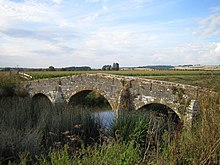
Brooke (or la Brooke, Broke, Brook, etc.) in the parish of Ilchester in Somerset, England, was an historic estate, the earliest known seat of the prominent Brooke family, Barons Cobham.

Brooke (or la Brooke, Broke, Brook, etc.) in the parish of Ilchester in Somerset, England, was an historic estate, the earliest known seat of the prominent Brooke family, Barons Cobham.
The exact location of the mansion or manor house, later known as "Brooke's Court", [2] is unknown and all physical traces of it have been lost. It was said by the Somerset historian Collinson to have been situated "without the walls (i.e. of the town of Ilchester) towards Montacute", which is to the south, thus probably to the west of the ancient estate of Sock Dennis, also situated to the immediate south of the town. Most of the estate lay in "Ilchester Mead" and included land "near the meadow of Sock and Martock". [3] Possibly the name derives from the brook or stream, now known as Bearley Brook, which separates Ilchester from Sock Dennis [4] and flows into the River Yeo 600 metres below Pill Bridge. The land extended to Pill Bridge, in the west, for the maintenance of which the estate was liable. [5]


The Brooke family (anciently "de la Brook" or "At-Brook") originated at the estate of "la Brook" [6] next to (juxta) the town of Ilchester in Somerset, and later resided at Holditch in the parish of Thorncombe and at Weycroft in the parish of Axminster, both in Devon, both fortified manor houses. Following the marriage of Sir Thomas III Brooke (died 1439) of Holditch in the parish of Thorncombe, Devon to the heiress Joan Braybroke, suo jure 5th Baroness Cobham (died 1442), he moved his residence to the manor of Cobham, Kent. The descent of the estate of Brooke is given as follows by Raphael Holinshed (c. 1525–1580?) in his Chronicles of England, which is followed by the Somerset historian Collinson (d.1793): [7]
Following the attainder of the 11th Baron, the estate of Brooke was granted by the King to Joseph Earth (d. 1609) of High Holborn, London. His heir was his brother Roger Earth, from whom it passed by means unknown to Sir Henry Berkeley of Yarlington in Somerset. [31]
Sir Henry Berkeley of Yarlington was a Member of Parliament for Ilchester. His daughter and heiress was Dorothy Berkeley, wife of Sir Francis Godolphin (1605–1667). [32]
Sir Francis Godolphin (1605–1667) married Dorothy Berkeley, the heiress of Brooke. In 1759 the manor of Brooke was owned by his grandson Francis Godolphin, 2nd Earl of Godolphin (1678–1766). The estate by then consisted of little else than the ownership of Pill Bridge. [33]

Ilchester is a village and civil parish, situated on the River Yeo or Ivel, five miles north of Yeovil, in the English county of Somerset. Originally a Roman town, and later a market town, Ilchester has a rich medieval history and was a notable settlement in the county; around the 12th and 13th centuries it was effectively the county town. It had, however, declined in size and importance by the beginning of the 18th century, and the last markets were held in 1833. In 1889 the historic corporation that had governed the town was dissolved.

Thorncombe is a village and civil parish in the English county of Dorset. It was historically, until 1844, an exclave of Devon. It lies five miles (8 km) south east of the town of Chard in neighbouring Somerset. Thorncombe is situated close to the borders of both Somerset and Devon. In the 2011 census the population of the civil parish was 687.
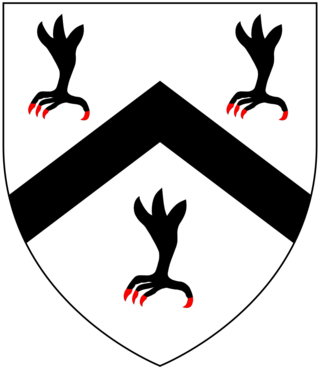
Edmund Braye, 1st Baron Braye, of Eaton Bray in Bedfordshire, was an English peer.
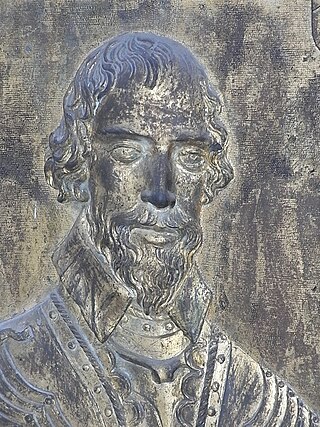
Sir John Wyndham, JP, of Orchard Wyndham in the parish of Watchet in Somerset, was an English landowner who played an important role in the establishment of defence organisation in the West Country against the threat of Spanish invasion.
Joan Brooke, suo jure 5th Baroness Cobham of Kent, was an English aristocrat.
Newenham Abbey was a Cistercian abbey founded in 1247 by Reginald II de Mohun (1206–1258) on land within his manor of Axminster in Devon, England. The site of the ruined abbey is a short distance south-west of the town of Axminster.
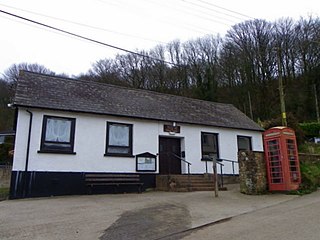
Blackborough is a hamlet and former manor in the parish of Kentisbeare, Devon, England. It is situated within the Mid Devon district. The nearest substantial town is Cullompton, approximately 4.7 miles (7.6 km) to the south-west. Within Blackborough are situated the large mansion of Blackborough House also notable are Hayne Farm and the Old Smithy. The former neo-Gothic Early English style parish church of All Saints, built in 1838 by George Wyndham, 4th Earl of Egremont, lord of the manor, who also built Blackborough House was demolished in 1994, having become structurally unsafe. The churchyard however is still maintained and the ecclesiastical parish and parochial church council still exist.
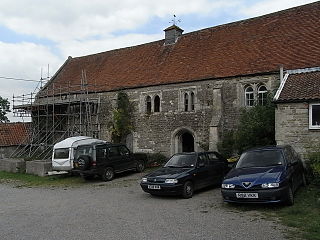
Brook in the parish of Heywood, north of Westbury in Wiltshire, England, is an historic estate. It was the seat of Robert Willoughby, 1st Baron Willoughby de Broke, KG, an important supporter of King Henry VII, whose title unusually incorporates the name of his seat, in order to differentiate him from his ancestors Barons Willoughby of Eresby, seated at Eresby Manor near Spilsby in Lincolnshire. A medieval wing survives of the mansion house known as Brook Hall, a Grade I listed building which stands near the Biss Brook.
The surname Denys was borne by at least three prominent mediaeval families seated in Gloucestershire, Somerset and Devon in southwest England between 1166 and 1641. It is not known if any relationship existed between these families. The surname Denys is just one of many variant spellings of the name: Denise, Le Deneis, Le Danies, le Deneys ,and most recently Dennis, are some of the others.
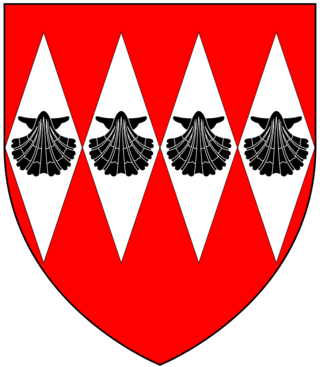
Sir Ralph Cheyne, of Brooke, in the parish of Westbury in Wiltshire, was three times a Member of Parliament for Wiltshire and was Deputy Justiciar of Ireland in 1373 and Lord Chancellor of Ireland 1383–4. He was Deputy Warden of the Cinque Ports.

Henry Fownes Luttrell, of Dunster Castle, Somerset, was High Sheriff of Somerset from 1754 to 1755 and a Member of Parliament for the borough of Minehead from 1768 to 1774.

The manor of Wadham in the parish of Knowstone in north Devon and the nearby manors of Chenudestane and Chenuestan are listed in the Domesday Book of 1086:

The Manor of Poltimore is a former manor in Devon, England. The manor house known as Poltimore House survives in its 18th-century remodelled form, but has been dilapidated for several decades. A charity named the "Poltimore House Trust" has been established for the purpose of its restoration. The manor was situated within the historic Wonford Hundred and was largely coterminous with the parish of Poltimore and contained the village of Poltimore, 4 miles (6.4 km) north-east of the historic centre of the City of Exeter. It should not be confused with the eponymous Devon estate of Poltimore in the parish of Farway, 16 miles (26 km) east of Exeter. Poltimore was the principal seat of the Bampfylde family from c. 1300 to 1920.
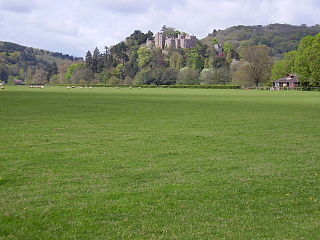
The feudal barony of Dunster was an English feudal barony with its caput at Dunster Castle in Somerset. During the reign of King Henry I (1100–1135) the barony comprised forty knight's fees and was later enlarged. In about 1150 the manors retained in demesne were Dunster, Minehead, Cutcombe, Kilton and Carhampton in Somerset, and Ham in Dorset.

Kittisford is a historic manor near Wellington in Somerset, England. It is situated on the River Tone, south of the village of Bathealton. The surviving manor house is called Kittisford Barton, situated formerly within the historic parish of Kittisford, now amalgamated into the parish of Stawley. It was built in the late 15th or early 16th century. It is a Grade II* listed building.

The Lyttelton family is a British aristocratic family. Over time, several members of the Lyttelton family were made knights, baronets and peers. Hereditary titles held by the Lyttelton family include the viscountcies of Cobham and Chandos, as well as the Lyttelton barony and Lyttelton baronetcy. Several other members of the family have also risen to prominence, particularly in the field of cricket.

Fardel is a historic manor in the parish of Cornwood, in the South Hams district of Devon. It was successively the seat of the Raleigh and Hele families. The surviving Grade I listed medieval manor house is situated about half-way between Cornwood and Ivybridge, just outside the Dartmoor National Park on its south-western border.

The title Baron Cobham has been created numerous times in the Peerage of England; often multiple creations have been extant simultaneously, especially in the fourteenth century.

Weycroft is an historic manor in the parish of Axminster in Devon, England. The surviving manor house known as "Weycroft Hall" is a Grade I listed building which includes elements from the 15th, 16th and 17th centuries, with a great hall of circa 1400, and was restored in the 19th century.

Sir Thomas Brooke (c.1355-1418) of Holditch in the parish of Thorncombe in Devon and of la Brooke in the parish of Ilchester in Somerset, was "by far the largest landowner in Somerset" and served 13 times as a Member of Parliament for Somerset. He was the first prominent member of his family, largely due to the great wealth he acquired from his marriage to a wealthy widow. The monumental brass of Sir Thomas Brooke and his wife survives in Thorncombe Church.